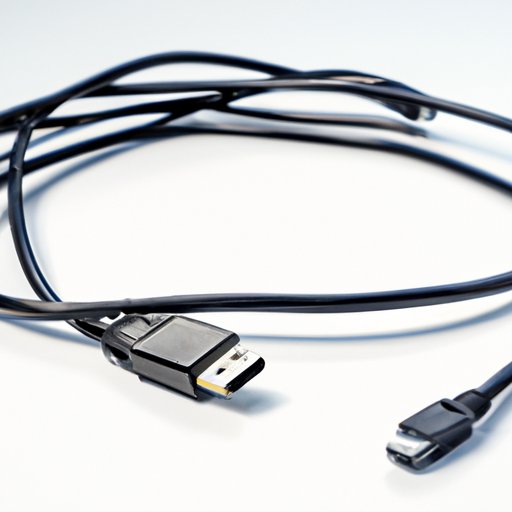
Introduction
Transferring files between PCs can be a daunting task, especially if you are not tech-savvy. Whether you want to transfer photos, videos, documents or any other file type, it is essential to know different ways of transferring files from one PC to another. Knowing the best methods of transferring files can save you time and prevent you from losing important files in the process.
Using a USB Drive
A USB drive is the most popular method of transferring files between PCs. Follow these steps to transfer files using a USB drive:
- Insert the USB drive into the USB port of the computer where the files are stored.
- Select the files you want to transfer by clicking and dragging the files to the USB drive.
- Eject the USB drive from the computer and insert it into the USB port of the destination computer.
- Copy and paste the files to the desired location on the destination computer.
There are several benefits of using a USB drive to transfer files, including convenience and portability. However, USB drives have a limited storage capacity and can be easily lost or stolen.
Over the Network
Transferring files over a local network is easy and straightforward. Here’s how:
- Ensure both computers are connected to the same local network. You can do this by connecting both computers to the same Wi-Fi network or by connecting them with an Ethernet cable.
- Enable file sharing on the computer where the files are stored. Go to the folder that contains the files you want to transfer, right-click on the folder and select “Properties.” Then click on the “Sharing” tab and select “Share this folder” and “Allow network users to change my files.”
- Open the other computer and navigate to the network folder. Double-click to open the shared folder.
- Copy and paste the files to the desired location on the destination computer.
Transferring files over a local network has several benefits, including speed and ease of use. However, ensure both computers are on the same network and have enabled file sharing.
Using an External Hard Drive
An external hard drive is an excellent option for transferring large files or a high volume of files. Follow these steps when transferring files using an external hard drive:
- Connect the external hard drive to the computer where the files are stored.
- Select the files you want to transfer by clicking and dragging the files to the external hard drive.
- Eject the external hard drive from the computer and connect it to the destination computer.
- Copy and paste the files to the desired location on the destination computer.
Using an external hard drive has several advantages, including large storage capacity, speed, and ease of use. However, they are not portable and can be easily damaged or lost.
Using Cloud Storage Services
Cloud storage services like Google Drive, DropBox, and OneDrive allow you to transfer files between PCs easily. Use these steps to transfer files using cloud storage services:
- Upload the files to the cloud storage service from the computer where the files are stored.
- Sign in to the same cloud storage service account on the destination computer.
- Download the files to the destination computer.
Using cloud storage services has several benefits, including large storage capacity and ease of use. However, you need a stable internet connection to upload and download files.
Using an Ethernet Cable
Using an Ethernet cable is an ideal option for transferring large files. Follow these steps when transferring files using an Ethernet cable:
- Connect an Ethernet cable to both computers.
- Enable file sharing on the computer where the files are stored. Right-click on the folder containing the files and select “Properties,” then “Sharing,” and select “Share this folder.”
- Open the other computer and navigate to the network folder. Double-click to open the shared folder.
- Copy and paste the files to the desired location on the destination computer.
Using an Ethernet cable has several advantages, including high speed and ease of use. However, you need an Ethernet cable, which can be inconvenient.
Using Email
Using email is an easy way to transfer small files. Use these steps when transferring files using email:
- Attach the files to an email message and send them to an email account accessible from the destination computer.
- Open the email account on the destination computer and download the file attachments.
Using email has several benefits, including ease of use, no additional software required, and no installation. However, you can only transfer small files, and the process can be slow.
Using a Transfer Cable
A transfer cable is an ideal method of transferring data between two PCs. Use these steps when transferring files using a transfer cable:
- Connect the transfer cable to both computers.
- Download and install the data transfer software that comes with the transfer cable.
- Follow the on-screen prompts to transfer the files from the source computer to the destination computer.
Using a transfer cable has several advantages, including high speed, easy to use, and it can transfer large files. However, they can be expensive and require additional software.
Conclusion
Transferring files between PCs can be a daunting task, but choosing the right method can make it easy and straightforward. Use this guide to determine the best method for your needs. Remember to consider factors such as the size of the file, the number of files, and the speed of transfer.
Key Takeaways
- Transferring files between PCs is essential and can save you time.
- There are several methods of transferring files between PCs, including using a USB drive, over the network, an external hard drive, cloud storage services, an Ethernet cable, email, and a transfer cable.
- Choosing the right method depends on the size and number of files you want to transfer, your internet speed, convenience, and privacy.





